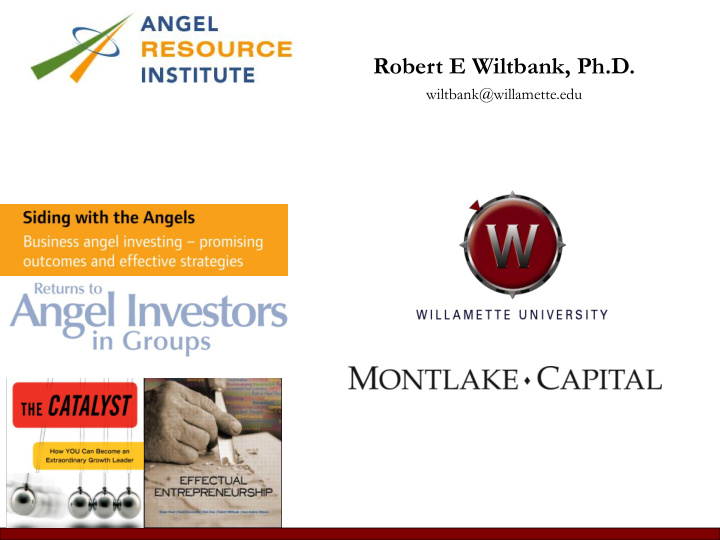



Robert E Wiltbank, Ph.D. wiltbank@willamette.edu
VERY Active Angels • Interviewed 20+ “Super” Angels • Average of about 30 business angel investments. • Min $8M invested (max of $100M) Amgen, Autocad, Google, Intel, Apple, Twitter, National Semiconductor, Sun Micro, Plaxo, Guidant, Silicon Valley Bank, Teledyne
Searching For Something • What role does their network play in their investing? • What is their approach to angel investing? Criteria, Strategy, Process, “Rules” etc. • How do they manage investments after the fact? • What have they learned along the way?
3 key findings to date • From experience: Better at reading people – No quitters, no liars, no jerks, big passion – real FIT between the person and the opportunity. – Some love “ coachability ” but not all. • Major Sector Focus – Med Devices is not Bio Tech – Consumer Internet is not Network Technology – Software is not hardware. – Software isn’t even software • Strategies: Equifinality
Equifinality: Many paths same end • Broad & Thin , support in “key moments,” team interaction is critical, no follow- on unless “no - brainer” • Co-Founder : start with 100% ownership, use it to build team and opportunity, investment = pay expenses • Sector Expert : go deep on funding as needed, forget co-investors, work with experts you know Strategic Coherence: Yes (with exceptions)
Implications for Angel Investing • Speed? angels in groups have formalized, super angels moving significantly more quickly. • Patience? debate over the role of exit strategies and early exits vs. ability to stay patient. • Group Think? groups always need to refine their decision making dynamics. Influence of just a few? 1 negative idea?
Returns to Invested Capital • Smaller venture deals do get to exits • The returns to those deals are quite attractive Acquisitions of Private Ventures by Public Corporations Median Median Paid Median Sum of Sum Paid In Aggregate Aggregate Profit $'s Hypothetical Paid In Capital Range Deal Count Price in Capital Multiple Price Capital Multiple Profit per deal ROI $5M-$100M 322 60.2 14.0 3.5 34,914 8,260 4.2 26,654 82.8 20% 30% failure rate under $5M 1,359 10.3 0.2 53.6 35,741 931 38.4 34,810 25.6 48% 70% failure rate Whole Sample 1,530 14.8 0.5 24.5 70,655 9,192 7.7 61,463 40.2 29% Includes ONLY deals with a MULTIPLE OF AT LEAST 1 Includes ONLY deals with complete data (70% of transactions) ROI equates if 3 and 7 year holding periods ROI equates if smaller deals fail 91% of the time Robert E Wiltbank, Ph.D
Distribution of Returns by Venture Investment 60 Hold: 3.0 yrs. 50 UK: Overall Multiple: 2.2X Holding Period: 3.6 years Approx 22% IRR 40 US: Overall Multiple: 2.6X Hold: 3.3 yrs. Percent of Exits Holding Period: 3.5 years Approx 27% IRR 30 20 10 Hold: 4.6 yrs. Hold: 4.9 yrs. Hold: 6.0+ yrs. - <1X 1X to 5X 5X to 10X 10X to 30X >30X Exit Multiple Red Bars: U.K. % of exits in that Category Blue bars: U.S. % of exits in that Category
Robert E Wiltbank, Ph.D. wiltbank@willamette.edu
Recommend
More recommend